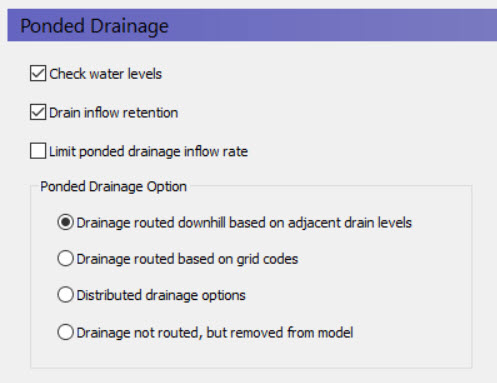

The OL Drainage function requires a reference system for linking the drainage to a recipient node or cell. The recipient can be a MIKE Hydro River node, another OL grid cell, or a model boundary.
The Ponded Drainage module is complex. The section Overland and Ponded Drainage (V1 p. 501) includes a lot of helpful information on using the this module
Check water levels - This means that the destination water level must be lower than the ponded water level in the cell.
Drain flow retention - If this option is OFF (default), then the OL Drainage is instantaneous. If this option is on, then you must specify a Inflow Time Constant (new data tree item), which restricts the rate of inflow to the drain. In other words, some ponding will be retained on the surface at the end of the time step - even if the time constant is very high.
Limit ponded drainage inflow rate - If the Drain flow retention option is ON, then you can optionally also specify a maximum inflow rate. If the Limited ponded drainage inflow rate option is ON, then a new data tree item for the maximum inflow rate to the drain will be added. This supports culverts, etc that restrict drain inflow
There are four different options for setting up the drainage source-recipient reference system
· Routed downhill based on drain levels - routed to the nearest downhill river, boundary or internal depression
· Routed based on grid codes - routed to the nearest river or boundary with the same grid code.
· Distributed drainage options - routing to specified River Links or MIKE Urban manholes
· Drainage not routed, but removed
Related Items
· Overland Flow - Technical Reference (V1 p. 459)
· Working with Overland Flow and Ponding- User Guide (V1 p. 483)
· Overland and Ponded Drainage (V1 p. 501)
· Time varying OL drainage parameters (V1 p. 749)